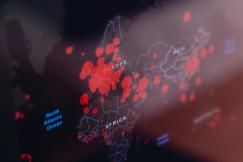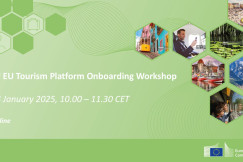Data
16 September 2024
EU Tourism Dashboard: A Comprehensive Tool for Policy Makers and Industry Stakeholders
Data
16 September 2024
Adventure tourism
Coastal, maritime and inland water tourism
Cultural tourism
+65 more
Login / create an account to be able to react
-
336

The EU Tourism Dashboard is an essential resource designed to support policymakers, tourism operators, researchers, statistical officers, and the general public in understanding and enhancing the tourism ecosystem. Developed by the Joint Research Centre in collaboration with DG GROW, the dashboard features a comprehensive set of indicators that measure and estimate the current conditions of the tourism sector. These indicators track progress towards achieving lower environmental impacts, higher digitalisation, and greater socio-economic resilience.
European Commission
Topics
Albania
Armenia
Austria
Belgium
Bosnia and Herzegovina
Bulgaria
Croatia
Cyprus
Czechia
Denmark
Estonia
EU-27
Finland
France
Georgia
Germany
Greece
Hungary
Iceland
Ireland
Italy
Kosovo
Latvia
Liechtenstein
Lithuania
Luxembourg
Malta
Moldova
Montenegro
Netherlands
North Macedonia
Norway
Poland
Portugal
Romania
Serbia
Slovakia
Slovenia
Spain
Sweden
Switzerland
Türkiye
Ukraine
Academic / Research and VET Institutions
Company with 250 or more employees
Consumer Organisations
Cultural and Heritage Organisations
Destination Management & Marketing Organisations
EU Institutions
Financial Institutions and Investors
Industry Associations and Chambers of Commerce
International Organisations
Local Authorities
Media / Journalist Organisations
National authorities
Networks and Federations / Confederations
NGOs / Non-profits
Regional Authorities
SMEs (a company with less than 250 employees)
Trade Unions
-
Specific types of tourism
-
-
Adventure tourism
-
Coastal, maritime and inland water tourism
-
Cultural tourism
-
Ecotourism
-
Education tourism
-
Festival tourism
-
Gastronomy tourism
-
Health and medical tourism
-
MICE tourism
-
Mountain tourism
-
Religious tourism
-
Rural tourism
-
Sports tourism
-
Urban/city tourism
-
Wellness tourism
-
-
Transition Pathway Strategic Areas
-
-
Accessible tourism services
-
Best practices, peer learning and networking
-
Changes in tourism demand and opportunities
-
Circularity of tourism services
-
Coordinated information on travelling
-
Cross-border travelling
-
Digitalisation of tourism SMEs and destinations
-
Equal and fair tourism jobs
-
Funding and support measures
-
Governance of tourism destinations
-
Green Transition of Tourism Companies and SMEs
-
Improving formal education
-
Improving statistics and indicators
-
Innovative tourism services
-
Multimodal travelling
-
Online visibility of tourism offer
-
Pact for skills
-
Promoting PEF/OEF methods for tourism
-
R&I on climate-friendly tourism
-
R&I on digital tools for tourism
-
Short-term rentals
-
Skills needs for twin transition
-
Sustainable mobility
-
Tools for data on tourism
-
Tourism strategies
-
Training opportunities
-
Well-being of residents
-
-
Business activities
-
-
Activities of amusement parks and theme parks
-
Activities of associations and other organisations supporting tourism
-
Air passenger transport
-
Camping grounds, recreational vehicle parks and trailer parks
-
Events catering and other food services
-
Festivals, cultural and entertainment activities
-
Gardens and nature reserves activities
-
Holiday Housing / Apartments and other short stay accommodation
-
Hotel and similar accommodation
-
Mobile beverage services
-
Mobile food services
-
Museums
-
Operation of historical sites
-
Other
-
Other accommodation
-
Other amusement and recreation activities
-
Other food and beverage services
-
Other holiday reservation services
-
Other tourism transportation activities
-
Rail Passenger transport
-
Recreational and sport activities
-
Restaurants, cafes and bars (Food and Beverage serving activities)
-
Road passenger transport
-
Tour operator activities
-
Travel agency activities
-
Water (sea, coastal and inland) passenger transport
-
Share
The dashboard's indicators are crafted to be comparable across time and space, ensuring consistent analysis regardless of the size of reporting units, such as countries or regions. Each indicator is expressed in relevant units of measurement, ranging from less to more desirable outcomes. For example, a high value in 'tourism diversity' is favorable, while a high value in 'tourism energy intensity' is not.
The EU is one of the world's most prominent tourist destinations, attracting hundreds of millions of domestic and international visitors annually due to its natural diversity, cultural heritage, and economic importance. In 2019, the travel and tourism sector contributed approximately 11% to the EU’s employment, encompassing direct, indirect, and induced jobs. However, the economic contribution of tourism varies significantly across EU countries and regions. Beyond its economic impact, tourism promotes European culture and heritage, enhances well-being, and generates opportunities for personal, cultural, and economic exchanges.
The EU Industrial Strategy update (COM(2021) 350 final) underscores the need to accelerate green and digital transitions, particularly for ecosystems heavily impacted by COVID-19, such as tourism. In response, DG GROW initiated the co-creation process of the Transition Pathway for Tourism in June 2021, involving industry, public authorities, social partners, and other stakeholders. Concurrently, the Council of the European Union invited the Commission to collaborate with Member States and relevant international organizations to design the EU Tourism Dashboard as a flagship tool for the tourism ecosystem.
The Transition Pathway for Tourism, published in February 2022, identifies 27 areas of action for the green and digital transition and improving the resilience of EU tourism. It calls for more circular and environmentally-friendly services, enhanced data sharing for innovative services, and improved diversity and accessibility of services.
The EU Tourism Dashboard, released as a proof-of-concept in December 2021 and fully available to the public since October 2022, supports the Transition Pathway by monitoring environmental, digital, and socio-economic aspects of tourism through harmonized data and indicators. The dashboard provides data at the country level (NUTS0) and, for a subset of indicators, at sub-national levels (NUTS2 and NUTS3), facilitating the collection, development, and harmonization of European regional statistics.
To sum up, the EU Tourism Dashboard is a crucial tool for informed decision-making, enabling stakeholders to monitor and enhance the tourism ecosystem's sustainability, digitalization, and resilience.
For an in-depth analysis and further insights, please visit the linked source on the left-hand side of the platform.
#Tourism indicators #Tourism sustainability indicators #Reports
Comments (0)
Related content
See also
-
13
Sign-up for the Sustainable EU Tourism Twinning Workshop
- Categories
- Coastal, maritime and inland water tourism Cultural tourism Ecotourism +64 more
-
14
Sustainable EU Tourism - Key challenges and best practices
- Categories
- Coastal, maritime and inland water tourism Cultural tourism Ecotourism +64 more
-
70
Last Chance to Register for the 1st EU Tourism Platform Onboarding Workshop!
- Categories
- Coastal, maritime and inland water tourism Cultural tourism Ecotourism +64 more




